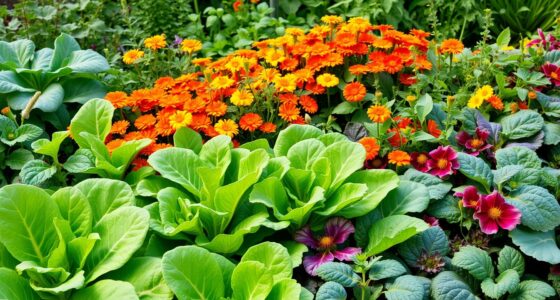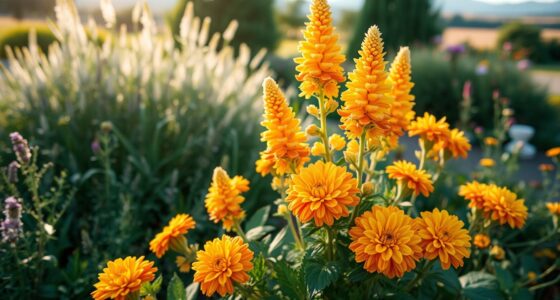To boost your rose garden’s beauty and health, plant companions like marigolds, lavender, chives, garlic, alliums, foxgloves, nasturtiums, and geraniums nearby. These plants help repel pests naturally, attract beneficial insects, and add vibrant visual contrast. Plus, many serve as ground cover or support the overall ecosystem. If you want to know how to optimize your garden for thriving roses, keep exploring these helpful pairing tips.
Key Takeaways
- Marigolds, lavender, chives, garlic, and alliums repel pests and attract beneficial insects, promoting healthier rose growth.
- Nasturtiums and foxgloves add visual interest, attract pollinators, and serve as natural pest barriers.
- Ground cover plants like nasturtiums suppress weeds and improve garden organization.
- Proper soil, watering, and mulching enhance the health of roses and their companion plants.
- Strategic color pairing and garden design create vibrant, harmonious landscapes around roses.
Marigolds

Have you considered planting marigolds near your roses? These vibrant flowers do more than brighten your garden—they act as natural pest repellents. Marigolds release compounds that deter nematodes and aphids, common pests that threaten rose health. Their bright orange and yellow hues attract beneficial insects like ladybugs and predatory wasps, which help keep harmful pests in check. Planting marigolds at the base of your roses creates a barrier that confuses and repels unwanted insects, reducing the need for chemical sprays. Additionally, marigolds are easy to grow, thrive in full sun, and require minimal maintenance. Incorporating them into your rose garden not only enhances visual appeal but also promotes a healthier, pest-resistant environment for your beloved roses. Leveraging natural pest control methods can further improve your garden’s health and reduce chemical use. To maximize their effectiveness, ensure proper plant spacing and regular watering to keep the marigolds healthy and vigorous. Proper garden maintenance can also prolong the life of your marigolds and enhance their pest-repelling properties.
Lavender

Why should you consider planting lavender near your roses? Lavender attracts beneficial insects like bees and pollinators that help your roses thrive. Its strong scent repels pests such as aphids and moths, protecting your blooms naturally. Lavender also acts as a drought-tolerant companion, needing similar care and watering routines as roses. Its upright growth adds visual contrast, enhancing your garden’s aesthetic. Plus, the fragrant aroma of lavender can improve your garden’s overall scent, making it a more enjoyable space. Planting lavender nearby encourages a healthy, balanced ecosystem, reducing the need for chemical treatments. Additionally, incorporating sound vibrations into your gardening practices can promote plant growth and overall health. Understanding brewing techniques can also inspire a mindful approach to nurturing your garden, fostering patience and attention to detail. When combined with proper plant pairing strategies, lavender can significantly boost the resilience of your garden. Moreover, being aware of soil preferences ensures that lavender and roses thrive together in optimal conditions. This synergy can be further enhanced by soil amendments, which improve nutrient availability and soil structure.
Chives and Garlic

Pairing roses with chives and garlic offers both aesthetic and practical benefits. Chives and garlic act as natural pest repellents, deterring aphids, Japanese beetles, and spider mites that threaten your roses. Their fragrant leaves also help mask the scent of roses, making it harder for pests to locate them. Additionally, these plants don’t compete aggressively for nutrients or space, so they complement your rose garden without overshadowing it. The visual contrast of the slender, green chive and garlic leaves adds a fresh texture next to the broad rose foliage. Plus, you can harvest chives and garlic for culinary use, making your garden both beautiful and functional. Overall, these companions boost your roses’ health while providing a practical harvest.
Alliums
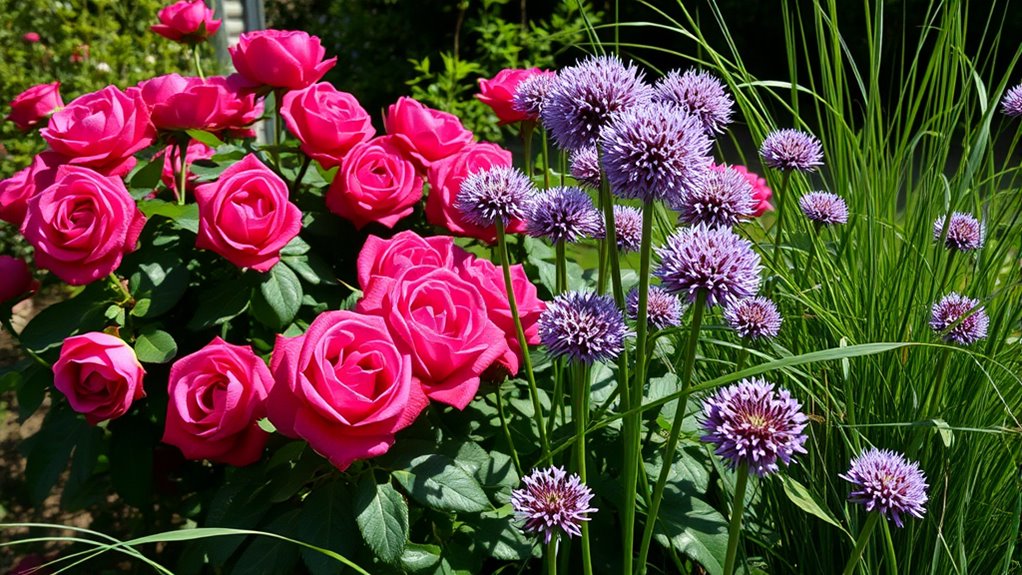
Alliums, including varieties like onions, leeks, and shallots, make excellent companions for roses because they help repel pests and improve overall plant health. Their strong scent deters aphids, borers, and other common rose pests, reducing the need for chemical treatments. Planting alliums near your roses also promotes better airflow, helping prevent fungal diseases like black spot and powdery mildew. These plants are easy to grow and don’t compete heavily for nutrients, making them a practical choice for your garden. Additionally, alliums attract beneficial insects such as pollinators and predatory wasps, which help keep pest populations in check. Incorporating alliums into your rose bed boosts plant vigor and creates a natural pest barrier, making your roses healthier and more vibrant. Proper plant placement is essential to maximize their pest-repelling effects and ensure healthy growth. Using companion planting techniques can further enhance your garden’s resilience against pests and diseases. Practicing mindfulness while tending your garden can enhance your connection with your plants and improve your overall gardening experience.
Foxgloves

Building on the pest-repelling benefits of alliums, foxgloves add both beauty and functionality to your rose garden. Their tall, elegant spikes of tubular flowers create a stunning vertical accent, attracting pollinators like bees and hummingbirds. Foxgloves thrive in partial shade, providing a lush backdrop that enhances your roses’ colors. They also act as a natural barrier, helping to deter pests such as aphids and beetles that may target your roses. Keep in mind that foxgloves are biennials or perennials, so they may need some patience to establish, but once mature, they’ll return year after year. Their striking appearance complements the delicate blooms of roses, creating a harmonious and vibrant garden display. Proper spacing ensures both plants flourish without overcrowding, and understanding the offensive security measures involved in pest control can help you better protect your garden. Additionally, selecting plants with natural pest-repellent properties can further enhance your garden’s resilience against common pests. Incorporating aesthetic wall organization elements such as trellises or decorative plant supports can also add visual interest and support your garden’s growth.
Nasturtiums
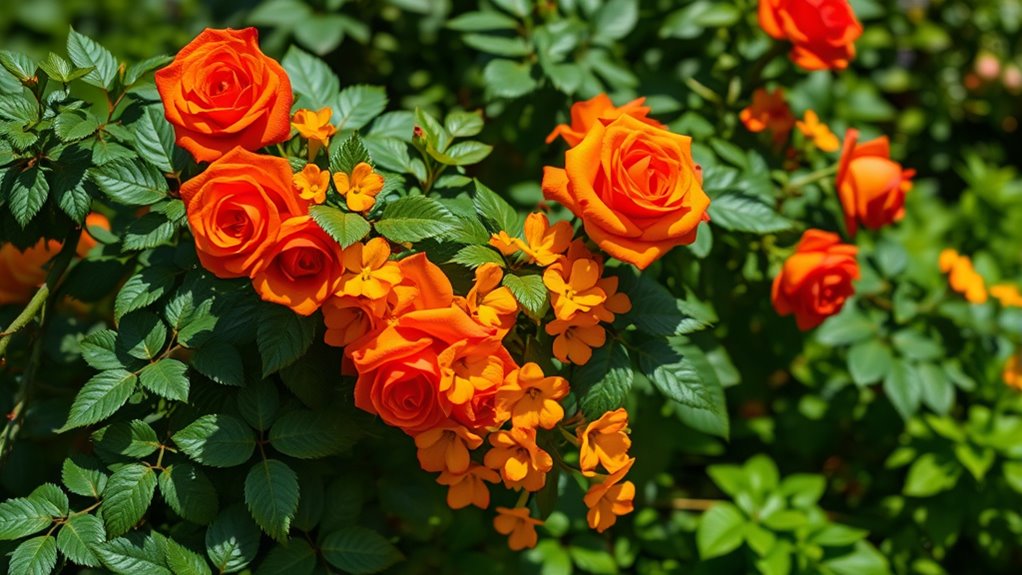
Nasturtiums are a great choice for your rose garden because they help keep pests away. Their bright, vibrant colors create a striking contrast with roses, enhancing your garden’s visual appeal. Plus, they act as an easy ground cover, protecting soil and reducing weed growth around your roses. Incorporating targeted planting strategies can further improve your garden’s health and productivity.
Pest Deterrent Qualities
Because nasturtiums produce strong, peppery scents, they effectively deter many common pests that target roses. Aphids, whiteflies, and beetles dislike the sharp aroma and tend to stay away. Their scent masks the smell of roses, making it harder for pests to locate their preferred plants. Nasturtiums also attract aphid predators like ladybugs and hoverflies, naturally reducing pest populations. Planting them around your roses creates a natural barrier that minimizes the need for chemical treatments. Additionally, nasturtiums are easy to grow and thrive in various conditions, making them an excellent choice for pest control. Incorporating companion planting with nasturtiums can further enhance your garden’s pest management strategy. By doing so, you can enjoy healthier, more vibrant blooms with fewer pest issues.
Bright Color Contrast
Have you considered how the vibrant orange and red hues of nasturtiums can enhance the visual appeal of your rose garden? These bold, colorful flowers create striking contrast against the softer tones of roses, making both plants stand out more vividly. Their bright colors draw the eye and add a lively, dynamic element to your garden design. Plant nasturtiums near your roses to create a mesmerizing display that energizes the space. The combination not only boosts visual interest but also highlights the beauty of your roses, making your garden more inviting. Plus, nasturtiums are easy to grow and maintain, providing a burst of color throughout the season. Understanding garden design principles can help you maximize the visual impact of your plant combinations and create a more harmonious garden. Incorporating companion planting techniques can further enhance plant health and aesthetic appeal. Using color contrast effectively can elevate your garden’s overall visual impact, making it more vibrant and engaging. Additionally, selecting plants with complementary textures can add depth and dimension to your planting scheme. With their eye-catching contrast, they’re an excellent choice for elevating your garden’s overall aesthetic.
Easy Ground Cover
One of the reasons nasturtiums make an excellent ground cover for your rose garden is their fast-growing, low-maintenance nature. They spread quickly, filling in space and suppressing weeds, which keeps your garden tidy. Nasturtiums thrive in full sun and well-drained soil, making them adaptable and easy to care for. Their vibrant leaves and colorful flowers add visual interest while protecting the soil from erosion. Because they’re drought-tolerant once established, you won’t need to water frequently. Plus, they attract beneficial insects like pollinators and pest predators, supporting your roses’ health. With minimal effort, nasturtiums create a lush, vibrant carpet that enhances your garden’s beauty and provides practical benefits, making them an ideal choice for ground cover around roses. Additionally, plant resilience ensures they remain vigorous and healthy even under challenging conditions. Implementing companion plants like nasturtiums can also align with the Law of Attraction, as positive energy and intentional gardening attract abundance and beauty to your garden space. Incorporating natural pest control strategies further enhances their role as beneficial ground cover in your rose garden.
Geraniums
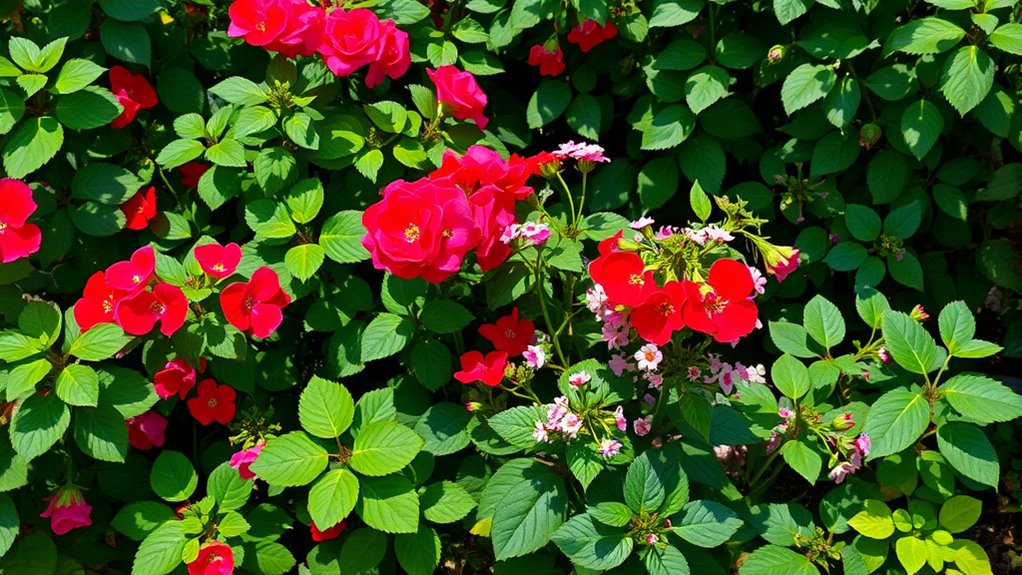
Geraniums are great companions for roses because they help keep pests at bay, protecting your plants naturally. Their bright blooms add vibrant color, complementing the roses’ beauty. Plus, they share similar soil and water needs, making them easy to grow together. Additionally, incorporating automation technologies in garden management can further enhance pest control and plant health. Using personal development techniques, gardeners can improve their skills and knowledge for better plant care and problem-solving.
Pest Deterrent Qualities
Geraniums are effective at deterring pests from roses because their strong scent repels insects like aphids and whiteflies. When you plant geraniums near your roses, you’ll notice fewer unwanted visitors. The aroma acts as a natural barrier, making it less attractive for pests to settle on your rose bushes. This reduces the need for chemical pesticides and promotes a healthier garden environment. Geraniums also attract beneficial insects, such as ladybugs, which help control pest populations naturally. Keep in mind that regular planting and maintenance enhance their effectiveness. Additionally, integrating companion planting techniques can further support pest control efforts. By choosing geraniums as companion plants, you create a protective shield that keeps pests at bay while adding vibrant color to your garden. Overall, they’re a simple, eco-friendly way to safeguard your roses.
Complementary Flower Colors
The vibrant colors of geraniums not only deter pests but also enhance the visual appeal of your rose garden. Their bold reds, pinks, and purples create a striking contrast against rose blooms, making your garden more lively. To achieve harmonious color combinations, consider pairing geraniums with complementary hues. For example, red geraniums look stunning next to white or soft pink roses, while purple geraniums work well with yellow or orange roses. This color coordination draws the eye and adds depth to your garden design.
| Geranium Color | Ideal Rose Colors |
|---|---|
| Red | White, Pink |
| Pink | Lavender, Cream |
| Purple | Yellow, Orange |
| White | Deep Red, Bright Pink |
Soil and Water Needs
To thrive alongside your roses, geraniums require well-draining soil that’s rich in nutrients. They prefer soil that retains moisture but doesn’t stay soggy, preventing root rot. Consistent watering keeps the soil evenly moist, especially during hot, dry periods, but avoid overwatering. Mulching helps retain moisture and maintain even soil temperature. Make sure your geraniums are watered deeply when the top inch of soil feels dry. Fertilize monthly with a balanced, water-soluble fertilizer to promote healthy growth. Proper watering and soil management support vibrant blooms and strong roots.
- Use well-draining, organic-rich soil
- Water deeply; avoid overwatering
- Mulch to conserve moisture
- Fertilize regularly during the growing season
Frequently Asked Questions
Can These Companion Plants Prevent Rose Diseases Effectively?
You wonder if companion plants can prevent rose diseases. While they won’t eliminate issues entirely, certain plants like garlic, chives, and marigolds can help by repelling pests and promoting healthy growth. These companions improve airflow and soil health, reducing disease risk. So, planting them alongside your roses can be a natural, supportive way to keep your roses healthier and more resistant to common ailments.
Do All These Plants Require the Same Watering Schedule?
You wonder if all these plants need the same watering schedule. Not quite. While some, like lavender, prefer well-drained soil and infrequent watering, others, such as ferns, like consistently moist soil. To keep your garden healthy, observe each plant’s needs and adapt your watering accordingly. Consistent, deep watering usually works well, but tailoring your approach ensures each plant thrives without over- or under-watering.
Are These Plants Suitable for Container Rose Gardening?
You can definitely grow these plants in containers with roses. Just make sure the containers have good drainage and are large enough for healthy root growth. Use high-quality potting soil, and water consistently to keep the soil moist but not soggy. Place the containers where they get sufficient sunlight. With proper care, these plants will thrive alongside your roses, creating a beautiful, vibrant garden.
How Do These Plants Affect Rose Growth and Flowering?
Imagine your roses transforming into show-stopping beauties that outshine even the brightest stars! The right companion plants do just that—they boost growth and flowering by providing essential nutrients, warding off pests, and improving soil health. When you choose wisely, these plants create a thriving symphony of beauty and energy, ensuring your roses flourish like never before. Your garden becomes a breathtaking masterpiece, bursting with color, fragrance, and life!
Can These Companions Attract Beneficial Insects to Roses?
You can attract beneficial insects to roses by planting companions that provide nectar and pollen, like marigolds, lavender, or daisies. These plants lure pollinators and natural pest predators, creating a balanced garden ecosystem. As a result, your roses benefit from reduced pest problems and improved health. By choosing the right companions, you encourage a diverse array of helpful insects, making your garden more vibrant and resilient.
Conclusion
By choosing these companion plants, you’re planting not just beauty, but a shield around your roses. Like loyal guardians standing tall, they symbolize harmony and protection, turning your garden into a sanctuary of growth and resilience. With each bloom and scent, you create a symphony of support that nurtures your roses’ health and vigor. Embrace these allies, and watch your garden flourish as a proof to nature’s perfect balance and enduring friendship.



